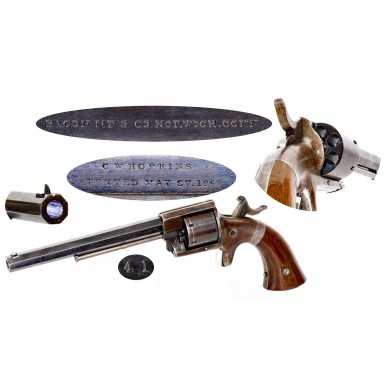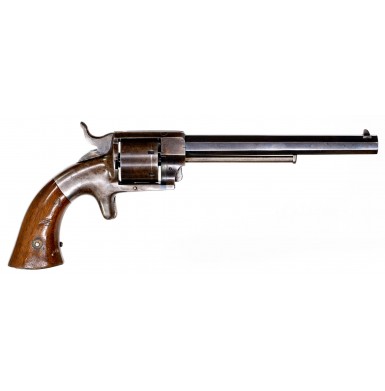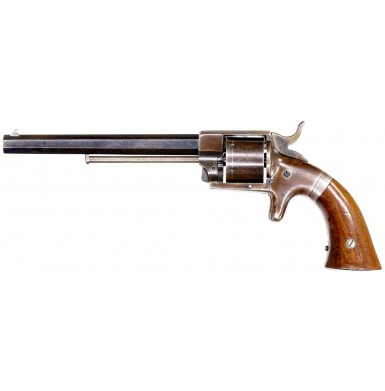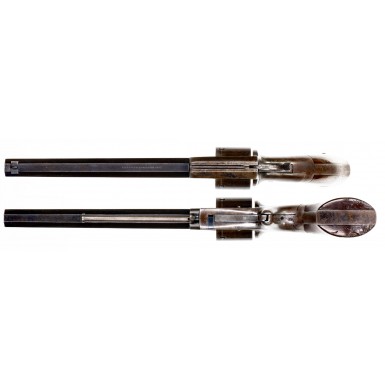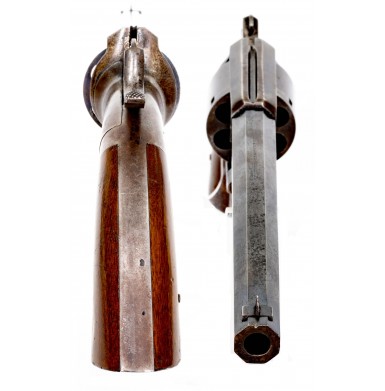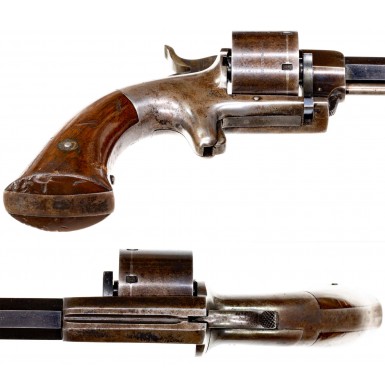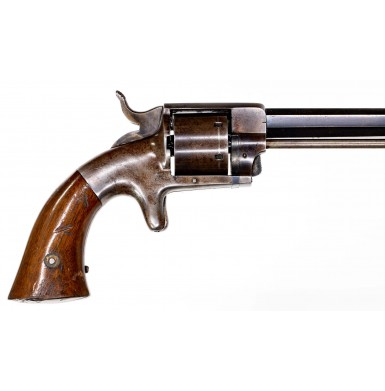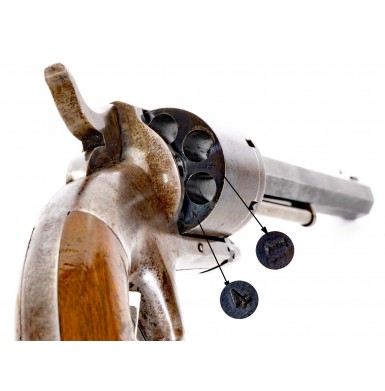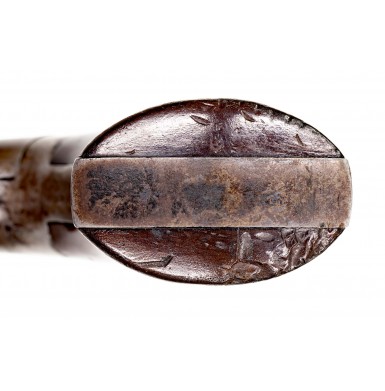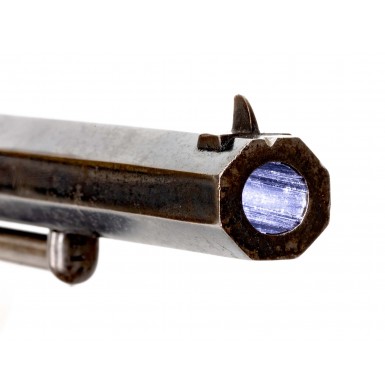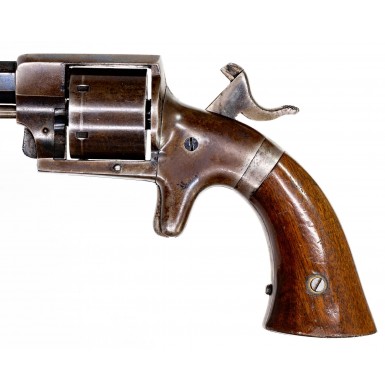Extremely Rare & Fine Bacon 2nd Model Navy Revolver
- Product Code: FHG-2323-SOLD
- Availability: Out Of Stock
-
$1.00
The story of the various gun companies that were established and run by Thomas K. Bacon is rather interesting and is a tale that has yet to be fully told in detail. From most accounts it appears that Bacon was a machinist, who seems to have had his first brush with firearms manufacturing in 1840, when he purchased some property in Grafton, Massachusetts from gun maker Ethan Allen. Two years later, both Allen and Bacon relocated to Norwich, Connecticut and it appears that the nearly simultaneous migration was not coincidental. By 1846, Allen factory records show that Bacon was operating as a parts supplier, producing “cones and triggerguards”. Bacon’s work as a “jobber” for Allen probably came to an end when Allen relocated his company to Worcester, Massachusetts in 1847. As a result, it appears that Bacon went into the firearms production business on his own, forming Bacon & Company in Norwich, which he ran until 1857.
The firearms produced by this early Bacon company were primarily inexpensive single-shot percussion arms such as pocket, bar hammer, ring trigger and under hammer pistols as well as some pepperboxes. In 1857, after an unsuccessful attempt to raise the necessary capital to expand his business into the fairly new, and very lucrative percussion revolver business, Bacon & Company went out of business. Bacon spent the next year working as the plant superintendent for the Manhattan Firearms Company (also located in Norwich), but was very soon operating his own business again. The newly formed Bacon Manufacturing Company was established in Norwich in 1858 and Bacon went into the business of producing revolvers. His product line included pocket percussion revolvers based upon the Colt 1849 “pocket” model and were offered under both the Bacon moniker and under various tradenames and with custom retailer markings. In addition to the traditional percussion revolvers, Bacon introduced a line of self-contained cartridge revolvers in .22, .25, .32 and even .38 rimfire. However, the majority of these revolvers were manufactured in violation of the Rollin White patent (#12,648) for the bored-through cylinder, which was held by Smith & Wesson. As a result, Smith & Wesson successfully sued Bacon, resulting in a monetary damages award, as well as requiring all subsequent Bacon revolvers (as well as those unsold and remaining in inventory) that utilized the bored through cylinders to be marked with Rollin White and Smith & Wesson patent information, with royalties paid to Smith & Wesson for each revolver of that pattern subsequently sold.
In 1863, the chief shareholder of the Bacon Manufacturing Company became displeased with Thomas Bacon’s performance with the company, forcing him out of the business. With Bacon gone, the company continued in business through 1868 but with lackluster sales and minimal success. The firm was subsequently reorganized in 1868 and was reestablished as the Hopkins & Allen company, remaining in business through the second decade of the 1900s.
However, Thomas Bacon was not to be defeated. By 1864 he had started his third firearms company in Norwich, CT; the Bacon Arms Company. His triumph was short lived however, as he sold the assets of his new business in December of 1865. This might have been a financial move due to the sudden changes in the firearms market brought on by the end of the Civil War. With the lucrative government contracts cancelled, the large American arms makers turned their attention to the civilian market and would certainly have been able to out-produce and out-promote any smaller maker. The sudden flood of cheap surplus military arms on the market certainly would not have helped the market share for a small, start-up firearms company either. The result was that Bacon’s final company became little more than a footnote in firearms history. Thomas Bacon worked at various jobs in the gun business for the next few years but died in 1873 and never achieved the level of success that his designs probably warranted.
Bacon’s “Navy” sized .38 rimfire revolver was certainly ahead of its time and one of the first American cartridge revolvers to be chambered in a potentially “man-stopping” caliber. His removable triggerguard pocket .32 rimfire revolver was also innovative, if somewhat short lived due to the Smith & Wesson lawsuit. Bacon also developed one of the first American cartridge revolvers to use a “swing out” cylinder, a truly innovative concept that was again stopped in its tracks by the Smith & Wesson suit. This feature was available in a pocket variation as well as the 2nd Model of his Navy revolver. Had Bacon been able to produce his “Navy” revolver with the swing out cylinder in sufficient quantities to attract the attention of the Ordnance Department, the history of self-contained cartridge United States military revolvers would probably be quite different. It is worth noting that the US Ordnance Department agreed that that potential to use White’s bored through cylinder patent to make more advanced cartridge revolvers during the Civil War had been a lost opportunity. In 1869 White’s original patent expired and he applied for a seven year extension. The Patent Office denied the request and in 1870 White lobbied Congress for relief. In response Congress passed a bill for relief which would allow White to receive his patent extension. However, the newly elected President Grant who had been the overall commanding general of the US forces during the Civil War vetoed the proposition, at the suggestion of his Chief of Ordnance Alexander Dyer. Dyer noted that the White’s constant suits and legal wrangling during the Civil War to prevent other manufacturers from taking advantage of the technological improvement had created an “inconvenience and embarrassment” for the Union during the trying times. He additionally noted that such an extension would “operate prejudicially to its (the Ordnance Department’s) interests by compelling it (the Ordnance Department) to pay to parties already well paid a large royalty for altering existing revolvers to use metallic cartridges.” Dyer also knew the extension would increase the cost of any new cartridge revolver that the government might look to adopt in the near future.
Offered here is one of Thomas Bacon’s historically important and extremely scarce Bacon Manufacturing Company 2nd Model Navy Revolvers (Flayderman 8A-015). Based upon available information, less than 1,000 of all variations of these .38 caliber rimfire revolvers were produced, in two distinct types and some sub-variations. The amount of minor manufacturing differences found in a revolver produced in relatively small quantities suggests that Bacon was never fully satisfied with the design and may have been making the improvements not only to try to evade the Smith & Wesson held White patent, but in an attempt to secure Ordnance Department contracts. The features common to all of the Bacon Navy Model Revolvers were that they were single-action, solid frame designs with a sheathed spur trigger. The guns had a six-shot cylinder and were chambered for the .38 rimfire cartridge. The revolvers had nominally 7 ½” long octagonal barrels, although some minor variations in length have been noted, with a dovetailed front sight and sighting groove in the topstrap for a rear sight. The guns were all blued with two-piece walnut grips and many of the early guns were typically decorated with loose scroll engraving on the frame behind the cylinder. Markings were sparse, with only a simple barrel mark reading BACON MF'G CO. NORWICH. CONN and with serial numbers on most of the major components appearing on all models. All of the 1st Model variants had to have their cylinders removed from the frame to load and unload the revolver, and for the most part the variations found in these 1st Model revolvers relate to the process of securing the cylinder to the frame and how the cylinder was removed from the frame. Some early examples relied upon a push button release, and one early variation had a knurled plate attached to the rear of the cylinder, which may have been an attempt to circumvent the Rollin White patent for the bored through cylinder. The 2nd Model Bacon Navy revolvers introduced the innovative swing out cylinder design to large frame cartridge revolvers. This feature had been patented by Charles W. Hopkins on May 27, 1862 (Patent #35,419) and was a concept ahead of its time, but only practical in conjunction with the bored-through cylinder. Interestingly Hopkins would be part of the group that would force Bacon out of his own company and would be a principle in the reorganization and establishment of Hopkins & Allen. It is generally estimated that only about 600 1st Model Bacon Navy revolvers were produced in all variations, with about 325 of the 2ndModel guns manufactured, all between about 1860 and 1863, with the loss of the Smith & Wesson lawsuit in 1862 sounding the death knell for the design. Those guns that were produced or were inventory unsold after Smith & Wesson and Rollin White won their suit against Bacon were additionally marked on the cylinder with the White patent date of April 3, 1855.
Offered here is a VERY FINE condition example of an extremely scarce 2nd Model Bacon Navy Revolver. The 2ndModel had an estimated production of roughly 325 guns, about half as many as were produced of the more “common” first model guns. However, with all first model production estimated at about 600 units, it is certainly an oxymoron to refer to it as “common”. All Bacon Navy revolvers are rare due to their very limited production. The 2nd Model guns were probably produced for less than a year, as the swing out cylinder that was the defining feature of that model did not receive its patent until May 27, 1862 and the Smith & Wesson lawsuit against Bacon was won later that year. With the cease and desist order in place to prevent the manufacture of guns with bored through cylinders and Bacon gone from the company by mid-1863, it is unlikely that these guns were produced for more than a few months from the summer of 1862 until early 1863 at the latest. This gun also has wonderful provenance, having once been part of the historic Locke collection of fine antique arms and is published in Frank Seller’s The William M. Locke Collection as the bottom pistol in a group of four Bacon Navy revolvers on page 375.
The revolver is serial number 41, and this number is found stamped under the left grip panel on the frame, under the barrel (concealed by the removable ejector rod), on the face of the ejector rod retention catch under the barrel and on the rear face of the cylinder. It is also lightly written in pencil on the interior of the right grip panel. The gun is the most prolifically marked of the Bacon Navy variants. It bears the standard barrel marking found on all version of the gun a single line roll-stamped on the top flat that reads:
BACON MF'G CO. NORWICH. CONN
The gun is additionally marked in two lines on the left side of the barrel:
C.W. HOPKINS
PATENTED MAY 27, 1862
This is a reference to Hopkins’ swing-out cylinder patent. The final marking is in a single line, vertically on the cylinder which reads:
PAT. APRIL 3, 1855
A reference to the Rollin White patent for the bored-through cylinder and marking required by the loss of the lawsuit filed by Smith & Wesson. In theory, all guns so marked resulted in a royalty payment to White.
The gun remains in really wonderful, original condition. As noted, all numbers match and all of the markings remain clear and crisp. Unlike most 1st Model Bacon Navy Revolvers, the 2nd Models were not typically engraved and this one is not. The operation of the revolver is quite simple. Placing the gun into the half-cock safety notch keeps the firing pin from contacting the rims of the cartridges. The spring loaded release at the lower front of the frame can then be depressed, allowing the cylinder to swing partially out of the frame to the right. Unlike later “swing out” designs, this one only exposes about one-third of the cylinder, with two chambers completely clear of the frame at a time. The cylinder can then be rotated, and cartridges inserted in the chambers. Should any fired cartridges need to be removed, the ejector rod below the barrel can be removed from its mount and used to push out the empty cases. Closing the cylinder makes the gun ready to be cocked and fired. A simple and elegant system that might have made a very useful military weapon during the Civil War.
As noted, the gun is in about VERY FINE condition and remains mechanically functional, operating as it should. The revolver opens and closes as it should, locks together crisply and the action operates as it should as well. The revolver times and indexes correctly and locks up tightly. The bore of the revolver is FINE and remains bright with crisp five groove rifling with the grooves slightly narrower than the lands. The bore shows no pitting to speak of, only some lightly scattered flecks of oxidation, some minor pinpricking and some frosting in the grooves. The revolver retains about 50%+ of its original blued finish overall, almost all of which is on the 7 ½” octagonal barrel. The barrel retains about 95%+ coverage of blue, with the bright blue rating about 65%+. The barrel shows the expected thinning and loss from handling and use, particularly along the high edges and contact points. The bottom of the barrel retains the most thick, dark blue, with the two lowered angled flats retaining slightly less, the side flats a little less than that and the two upper angled flats the top flats showing the most thinning and loss from handling and wear. The areas where the blue has faded or worn have a mostly smooth plum brown patina that is attractive and blends so well with the remaining blue that under normal lighting conditions the gun appears to retain much more of the blue on the barrel than under the harsh lights used for photography. The barrel is entirely smooth with no pitting to speak of however some flecks of minor surface oxidation are shot through the blue and there are some minute areas of pinpricking are present here and there. The only condition issue worth noting on the barrel is a small ding on the top flat at the muzzle that extends partially into the muzzle’s face. It is not clear if this is accidently or intentional, maybe an index mark from the owner to align the windage of the front sight. The original dovetailed front sight is in place on the barrel and retains about 50% of its original bright blue. What appears to the be the original ejector rod is in place under the barrel, secured by the original locking system. The cylinder retains some thinned blue, only about 10% with the balance a mixture of smooth pewter gray and gentle plum brown patina. There is a visible grayish turn line through the cylinder stop slots at the front end of the cylinder. Like the barrel, the cylinder shows no pitting, only some flecks of minor oxidation and some lightly scattered minor pinpricking. Even the chambers remain mostly bright and smooth. The fame retains only minute traces of blue in the protected nooks and crannies, with the balance a mostly smooth and even brownish patina, again free of any real pitting. The hammer retains about 80%+ vivid case coloring with some fading and loss and some scattered minor surface oxidation and minor roughness. The varnished two-piece grips retain nearly all of their original finish with some loss due to handling and use. They remain, solid, complete and free of any breaks or repairs. They do show some handling marks with some moderate impact marks on the bottoms and on the lower leading edge of the right grip. Otherwise, their mostly crisp appearance certainly matches the wonderfully crisp condition of the gun.
Overall, this is really wonderful, complete and 100% correct example of a very scarce 2nd Model Bacon Navy Revolverin really wonderful condition. With only about 325 of these rare revolvers produced, they do not appear on the market for sale on a regular basis. In fact, in the last twenty years this is the only example I have owned, although I have owned a handful of the earlier 1st Model guns. The gun retains substantial amounts of original finish and is certainly one of the best examples of these rare guns to survive today. This gun would be a wonderful addition to any advanced collection of early cartridge revolvers, particularly a collection of “secondary martial” American Civil War handguns, as the size and caliber make this a candidate for such a designation. It is certainly worth considering what the adoption of such an advanced cartridge revolver might have meant for Union cavalry forces during the Civil War, were it not for Rollin White’s and Smith & Wesson’s lawsuit. Any serious handgun collector would be extremely pleased to add this gun to their collection, and it will likely be a very long time before another of these rare guns comes to market, particularly in such wonderful condition. It could easily be another twenty years before you see another 2nd Model Bacon Navy Revolver for sale in such great condition, let alone better. Good luck upgrading this one!
SOLD
Tags: Extremely, Rare, Fine, Bacon, 2nd, Model, Navy, Revolver

